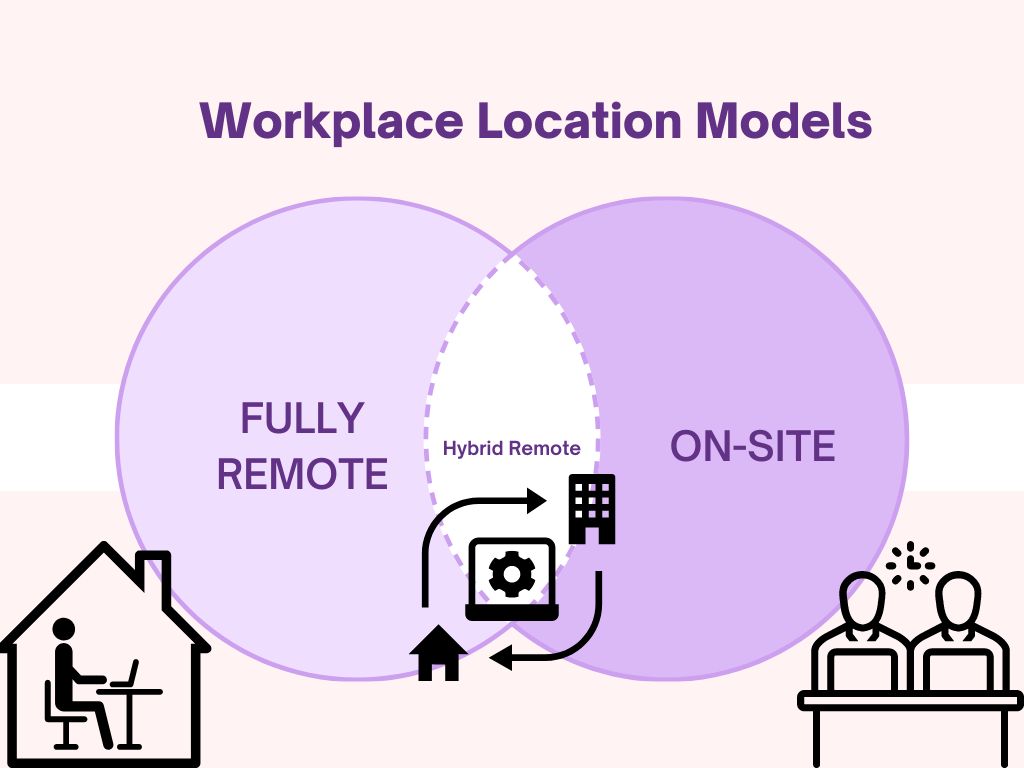Before the pandemic, the concept of a hybrid workplace was alien to most people. It hasn’t taken long for hybrid work (sometimes called hybrid remote work) to become normalized. Is the work-from-home environment the future of work? Quite possibly, although there’s plenty of evidence and numerous studies that indicate employers, at least, are not quite ready for this dramatic and sudden shift in work locations.
What Is the Difference Between Hybrid and Remote Work?
First, let’s put these two items in the simplest of terms:
- Hybrid work: Employees spend some of their time working from home, and some of their time working from a dedicated employer workspace or office. The home/office split could be anything, although 50/50 is increasingly seen as a nice compromise.
- Fully remote work: Employees spend all of their time working from home. They never have to come to the employer’s office. That doesn’t mean they can’t go to the office on occasion. For example, fully remote employees may come to the office for a week annually for a company retreat or conference. That would still count as the employee being fully remote, as it counts for such a small amount of their total time.
Hybrid work is a boon for both employers and employees in many ways. According to a Gallup study on hybrid and remote work, 67% of workers find that remote work makes them more efficient with their time, and 51% noted that they were more productive in this type of work arrangement.
However, workers are lonelier than ever, and part of that is due to the disconnection created by remote work vs on-site work. Even though 87% of workers will choose remote and hybrid workplaces when given the option (according to McKinsey), cutting themselves off from day-to-day physical interactions may be fueling what researchers are calling the Loneliness Epidemic.
Employers who plan to make hybrid remote and fully remote work the norm must also utilize strategies that boost employee connection and engagement.
There are far more details below, where we cover hybrid workplace models and the challenges of remote vs on-site. To note, however: Millennial and Gen Z workers are increasingly demanding this type of work arrangement.
Is hybrid working the same as remote working?
Often, people interchange the terms remote and hybrid work. However, they are fairly different.

Picture a Venn diagram. The first circle is for in-person setup, while the second is for the remote work setup. The overlap in the middle is the hybrid work model. Thus, a hybrid workplace combines in-office and remote work as options for employees to choose as their work setup. This setup provides support for in-office employees and remote employees and autonomy and flexibility for better work-life balance.
The idea of the hybrid workplace model is to reduce the stress of commuting and give employees the freedom to work from the comfort of their homes, should they want to, and show up to the office should they need to.
In a hybrid work model, it’s not uncommon for some employees to work remotely while others are on-site. The company usually decides which employees get to work on-site, which ones get to work remotely, and when employees should return to the office. However, some models allow flexibility for workers to decide their on-site/at-home schedule.
On the other hand, remote work is a setup where employees work from any location away from the office. They can work from a different city, state, or even overseas. Thus, in remote work, all employees follow a work-from-home (WFH) format; there is often (but not always) no headquarters or centralized office. This is why fully remote companies often hire talents from all over the world, and employees work and collaborate across different time zones.
For example, at MentorcliQ, our team is fully remote. However, we have a home office located in Columbus, Ohio. You can read more about our recent office renovations to support the hybrid work model we have at MentorcliQ. While many of our team members are based in Columbus and work from the home office, there is no expectation that anyone does. Our CBUS-based employees can come and go at will from the home office, while our remote teams (including myself, connecting in from New Orleans, Louisiana) are completely remote all the time.
An Overview of Hybrid Workplace Models
Today’s hybrid workplace is not a new concept. Many companies across different industries worldwide have offered this kind of varying work environment for their employees for quite some time. However, when the COVID-19 pandemic struck and forced companies to shift to remote work, what was a slow uptick became an almost immediate overnight culture shift.
In fact, the U.S. Census Bureau found that the number of people working remotely tripled between 2019 and 2022.
And a Gallup study found that, for those whose jobs can be done remotely, 78% report that they’re working from home either all or most of the time, or some of the time (with “some of the time” fitting the remote hybrid category completely).
Is hybrid work all about changing locations? Not quite. A large aspect of hybrid remote work is about changing how we work. Because many workers express increased productivity, more job satisfaction, and a better work-life balance from remote and hybrid workplace setups, this format leads to a change in how people are completing the work they’re assigned.
Virtual employees need some support! Mentoring can help, but how? Check out this Mentoring Soundbites video that includes some expert tips from Fortune 500 HR leaders explaining just how mentoring helps support virtual employees.
And for hesitant managers: Yes, they are still doing the work, despite your many hesitations. In fact, productivity intelligence company Prodoscore found that worker productivity increased during the pandemic because of working from home. It goes to show: decreasing the distraction of other people can lead to greater worker productivity.
With that said, there are four basic hybrid workplace models. Choosing one that suits your company’s size, style, products/services, company culture, etc., is crucial for its success. Here are the basic hybrid workplace models you should know.
50/50 combination
More and more organizations are implementing a 50-50 hybrid workplace model where they split the week with three days in person/in the office and a 50% split between remote work, hybrid, or in-office for the remaining days of the week.
This hybrid workplaces model is suited for businesses such as banks and data centers. However, some industries and companies that require solid in-person components may need help to follow this model.
Half-time remote + manager approved
Many companies today also allow their employees to work from the comforts of their own homes 50% of the time, with an opportunity to increase that duration by getting the manager’s approval.
This model provides many employees the flexibility to choose their work environment. It is also an ideal model for most knowledge workers that are required to report to the office or those who are part of a team for in-person collaboration.
Downsizing
Some organizations realized they no longer needed to maintain a large downtown real estate to keep the business rolling. Thus, they moved out of their old headquarters and kept some work completely remote. Remote workers now work from their homes permanently, while others are relocated to smaller and more affordable offices around the area.

Still, turnover costs you way more than your office space. Download our Employee Retention eBook to learn why turnover is so pricey, and how to you engagement strategies can fix it.
Customized
A customized model is what its name suggests – it provides the organization’s leaders the complete control to decide which setup (or combinations of models) works best for their organization. The goal of choosing the hybrid workplace model is to ensure maximum job satisfaction, higher efficiency, and productivity.
Challenges of Hybrid Workplace
All work models have their own challenges, and a hybrid workplace is no different. Here are some of the most common challenges you can expect from implementing a hybrid workplace model.
Finding and developing the suitable hybrid work model
You must design and build your hybrid workplace specific to your company, needs, goals, and team culture. You may need to use combinations of different models for hybrid workplaces and invest in the right technology (both hardware and software) to ensure hybrid workers have the right tools and the tried and tested methods.
Increased risk in security
Remote participants will be using their computers through their networks. That means they will have to access company documents and even sensitive data using their system at home, and more likely, they will use their own devices (desktop or laptop computers, smartphones, etc.).
And, most often than not, they have a different level of security in their systems and devices than you would have in your virtual office. Thus, the HR and IT departments need to focus on end-user education and invest in their employees’ enterprise cybersecurity solutions to protect the company’s interest.
Effective team and people management
In a hybrid work environment, managers must do their due diligence to ensure hybrid employees are all on the same page. Both in-office/on-site and remote workers should have equal access to opportunities and exposure, especially in evaluating individual productivity.

Moreover, evaluations must be based on the quality of their work rather than the work process itself. That way, employees working remotely can get prompt feedback on their work performance. Employees expect timely feedback and communication to ensure a streamlined workflow for all concerned.
More importantly, managers and supervisors should ensure remote workforce, especially those in a remote location, feel connected to the organization and their colleagues. The employees shouldn’t feel isolated or unrecognized. As we noted earlier, loneliness and feelings of disconnection are common problems in remote work environments. Finding a way to counter that will be important, or you could see productivity drop and turnover increase.
With all of that true, don’t give work-from-home or hybrid remote employees special treatment. They should be subject to the exact expectations (productivity, work hours, reporting, etc.) and accountability as their in-office colleagues. But you may need to supplement their engagement and connection with new people-centric strategies, such as mentorship programs and employee resource groups.
Employee disconnection and isolation
For a hybrid workplace model to work, it should support the needs of all employees and keep them integrated and engaged in the workforce, whether at home or in the office.
We noted this just above, but we’ll reiterate here again: HR teams must ensure hybrid employees feel connected with the organization and each other, wherever and whenever they are working.
This is where the importance of developing an excellent hybrid work culture comes into play. The organization should invest in opportunities for everyone to connect and interact with each other virtually. Moreover, HR should develop an organizational culture that values employee feedback. Regular feedback is also critical to boosting employee engagement.
Creating and ensuring seamless connectivity
Connectivity is the key to effective collaboration in a hybrid workplace. Thus, to ensure the free flow of knowledge and ideas and avoid disparities, the organization should establish channels for barrier-free communication. One of the best ways to do this is to have virtual conference rooms or meeting rooms designed to listen to what everyone has to say.
What Are the Pros and Cons of Hybrid Work?
A hybrid workplace gets the best of both worlds. Employees can enjoy occasional in-person interaction when they want it while still maintaining the flexibility and personal choice of a work-from-home setup.
Pros of a Hybrid Approach to Work
If you’re still on the fence about whether hybrid work is actually a good thing for workers, here are some positive benefits to chew on for a bit.
1. Better work-life balance through flexibility and freedom
A well-executed hybrid workplace prioritizes employee satisfaction (which results in positive ROI for any engagement programs you have in place) and inspires work-life balance.
Employees love their work, the work environment, and the perks of flexibility and freedom that comes with it. Moreover, organizations offering combinations of remote and in-person work setups often have a deeper talent pool, as businesses are no longer restricted and confined to hiring people in their specific geographical areas.
2. Saves your company a significant amount of money
Also, a hybrid workplace is more economical. There is less reliance on the organization to function on large-scale offices, allowing the business to save thousands of dollars in real estate and the overhead cost of maintaining a physical office.
A Global Workplace Analytics study found that companies can save an average of $11,000 per year for each employee that’s on a 50/50 hybrid model. That money can easily be put into other areas, such as employee engagement programs and software, which could be used to give employees pay increases, or used to shore up revenue.
3. Builds a more resilient workforce
A hybrid workplace can also help your organization build a resilient company culture that can withstand any type of external choas. Since everyone is already working from home, they already understand their roles; they know how to function and collaborate remotely and deliver the necessary work whenever and wherever they may be working.
4. Protects your employees
A hybrid workplace model is also an excellent way to reduce absenteeism. Multiple studies, including a 2021 study from The Council for Disability Awareness (CDA), find that remote work results in employees taking fewer sick days. As employees take fewer sick days, they’ll ultimately increase their productivity. Obviously, this is enhanced by a fully-remote working model, but even a hybrid remote model leads to fewer sick days as employees spend less time in what are, let’s face it, germ factories masquerading as office spaces.

According to WebMD, the germiest places in the office include:
- Elevators (buttons, specifically)
- Door handles
- Shared equipment or furniture, including desks, keyboards, and telephones
- Water coolers
- Coffeepots or/and coffee makers
- Kitchen surfaces, such as the sink, sponge, coffee mugs, utensils, and the microwave
- Coffee mugs
- Vending machines
- Restroom surfaces
That’s…pretty much everywhere. Gross. It’s ultimately difficult for workers to avoid these shared spaces.
Cons of a Hybrid Workplace Model
The hybrid workplace model has flaws, making it not the best model for everyone. Here are some disadvantages of a hybrid work setup. Identifying the cons will help you ensure that the hybrid work model you use (or ultimately don’t use) is aligned with your office culture and the need of your teams.
1. Not everyone has a space conducive to work
Since only some have the same level of access to a quality internet connection, designated workspaces at home, and distraction-free work environment, remote working can be a challenge for many organizations to implement. Working in a fully remote environment does not give employees access to the same resources as in an office environment.
This ultimately ends up being an equity is at times, as well. Many workers don’t have a dedicated office to work from, and are forced to do their remote work at home from improvised offices, such as dining room tables and laundry rooms.
Additionally, for women, who either by choice or culture often take on more childcare responsibilities, working from home eat away at to their productivity. That can impact their ability to perform at the level they’d want or need to succeed in their careers.
2. Remote employees may feel they need to be more appreciated
There will always be a concern that employees “seen” in the office premises are viewed as providing more work and better output than those who work remotely. This is what’s known as the proximity bias, in which individuals who are seen more physically are given preference by managers and leaders, even if that bias is unintentioanl.
Subsequently, this will make some employees feel passed up for opportunities just because they are less visible in the office than those who return to the office more frequently.
This is an essential issue that the organization’s leadership must address, especially since employee engagement is linked to productivity.
3. Communication and collaboration challenges
Another critical issue to address when you shift from in-office to a hybrid work setup is your remote and in-office workforce’s communication and collaboration. Even in the US, some workers may not have adequate access to strong and stable internet connections.
They may also live in a location where environmental interruptions, such as strong storms made worse and more frequent by climate change, make regular access to internet difficult during certain parts of the year. Thus, this could affect how they communicate and collaborate with their in-office and other remote colleagues.
What Impact Does Hybrid Work Have on Culture?
Humans are social creatures. We crave social connections and desire to work in teams. The pandemic may have forced many companies to make an unexpected shift, but remote work is now here to stay. A Pew study found that 76% of workers were teleworking by choice. People want to remain remote as much as possible. Responding to that with a hybrid model is a fair approach, but it’s also not an approach that can be treated the same a completely on-site.
Collaboration is important to company culture. Salesforce found that 75% of workers prefer interact with colleagues the same way they would with friends. That’s a level of culture that’s possibly difficult to foment when workers aren’t together in person without supplementing communication and collaboration in some way.
The remote working model paved the way to shift from traditional modes of communication to less formal ones, keeping co-workers’ connection and momentum even during the early days of the pandemic.
The use of collaboration tools and the effort to build a hybrid collaboration space is critical to the success of the organization’s different teams. From Zoom calls to Slack messages, it became more important to prioritize communication to ensure that everyone on the team is on the same page.
Is Your Business Ready for Sustained Hybrid Models?
The office environment is not dead; it will always be there. The hybrid workplace gives the workplace flexibility and provides employees with the option to choose the setup that is most suitable for their individual needs and productivity level. Take time to learn and implement the best practices for building a space that enables everyone to thrive.
With hybrid earning its place, makes sure you consider how you’ll continue to support communication, collaboration, employee engagement, skill development, career development, and DEI. That may sound like a lot of considerations to juggle, but that’s why mentoring programs are an excellent solution. It’s why 92% of Fortune 500 companies now use mentoring programs. They’ve learned that mentoring provides the rails for most of the trains human resource professionals are trying to pull these days.
What challenges have you faced switching to a hybrid model?
Leave us a comment and let us know!
Or, contact us today to learn more about how mentoring can solve your biggest employee engagement challenges in the age of hybrid and remote work.




